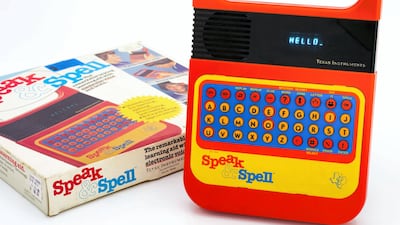It was 1980 when I first encountered Speak & Spell. This innovative educational toy, made by Texas Instruments, blew my tiny mind. Here was a handheld children’s computer that could help me improve my spelling, which was, and still is, atrocious. What’s more, it was fun. Made of bright red plastic with a yellow trim and a small digital screen, it was certainly eye-catching, but its most striking attribute was that it spoke. “Now spell colour”, its emotionless, robotic voice would command.
In 2009, long after Speak & Spell had been consigned to the archives of early digital technology, the US-based Institute for Electrical and Electronics Engineers awarded it “Milestone” status, declaring it a key achievement in electronic engineering. It may also have been the first sign of an impending revolution.
A recent article in The National described a research project by a team from UAE University's College of Information Technology that used robotics and artificial intelligence to help children on the autism spectrum with their learning and development. The research described how children on the autism spectrum paid more attention and responded better to simple instructions given by a robot than they did to those given by a human instructor.
It is not only in the context of autism that robots are getting involved in education. Earlier this year, primary schools across the city of Tampere in Finland got two new teachers − both of them robots. The first, named Elias, is small, humanoid in appearance and programmed to speak and understand 23 languages. It has been developed to recognise and understand the language ability of the specific child interacting with it, and to adapt the complexity of its own accordingly. Elias is also programmed to perform the “Gangnam Style” dance, which might be helpful when the class is getting bored. The other half of this robotic teaching duo is an egg-shaped invention known as OVObot, which is tasked with teaching maths.
Their deployment in classrooms is part of a pilot study to explore the impact of robots on teaching quality and educational progress. The study also aims to see how effective machines might be at taking charge of lessons. I find it disturbing that a robot could be used to stop unruly classroom behaviour – we’ve all seen RoboCop – and unlikely that it could comfort a crying child, but machines could very effectively record such incidents and report them back to their human overseers.
_____________________
Read more from Justin Thomas:
Young people are vulnerable to loneliness too
Psychologists cannot afford to ignore our valuable digital data trail
Why teachers need help just as much as their pupils
_____________________
This is the near future of education, as envisioned by Anthony Seldon and Oladimeji Abidoye in their recent co-authored book, The Fourth Education Revolution: Will Artificial Intelligence Liberate or Infantilise Humanity? In it, they assert that AI can easily outperform human teachers in the areas of information-giving and the tailoring of assessment to the specific needs of individual students. Gone will be the days of age-related year groups: if you are ready to progress, then you will. And RoboTeacher will lead the way.
It seems likely that artificial intelligence will become a major source of disruptive innovation in education in the coming decades. This is when a new technology displaces the old ways of doing things, in some cases rendering that which came before entirely obsolete. Netflix and Uber are good examples of disruption in entertainment and transport, but what could disruption in education look like?
For one thing, the AI classroom of the future might not even be a classroom. With the possibility of personalised instruction and immersive virtual reality, the need to gather students into large rooms with desks and whiteboards seems open to question. However, online educational methods possess little of the human interaction that classrooms and lecture halls provide. This is an important part of the learning experience for both children and adults, and should not be overlooked.
When one considers parts of the world where access to education in the form of well-educated professional teachers is scarce, the value of new, open and accessible methods of tutoring is clear. For the AI-empowered education revolution to genuinely take effect in these locations, though, considerable investment in technological infrastructure will be necessary.
As an educator, I believe that it’s wise to embrace change, to appreciate the potential of new and emerging technologies, and get ahead of the curve. From such a vantage point, teachers are in a perfect place to influence how the coming revolution will unfold. Like everything else, nobody can predict the future of learning, but one thing is certain – that the role of the teacher is going to change radically.
Still, it is unlikely that we will be replaced. With increasing use of technology, we may see an even greater need than ever for educators to focus on the social and emotional development of children. A teacher’s compassion and empathy can help struggling students find their way, to become inspired and flourish. We may have come a long way from Speak & Spell, but that invaluable human touch will always remain at the cutting edge of education.
Dr Justin Thomas is professor of psychology at Zayed University


